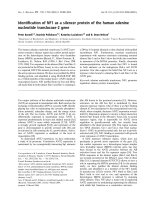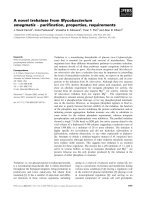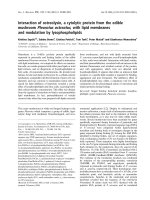Ohanin a novel protein from king cobra (ophiophagus hannah) venom 2
Bạn đang xem bản rút gọn của tài liệu. Xem và tải ngay bản đầy đủ của tài liệu tại đây (144.01 KB, 7 trang )
181
APPENDICES
Figure A.1 Map of pGEM
®
-T Easy Vector
182
Figure A.2 Production of recombinant proteins. (a) The expression vector contains the
lac promoter which drives the expression of lacZ gene encoding for β-
galactosidase. Lactose or its analog IPTG will stimulate the expression of β-
galactosidase. (b) If lacZ is replaced by the gene encoding the protein of interest, lactose
or IPTG will stimulate the expression of desired proteins.
Many proteins of interest are expressed in low concentration in endogenous system.
Through recombinant DNA technology as above, large quantities of recombinant proteins
can be produced using an in vitro expression system.
(Modified from
Note
Blue white selection: Many vectors (such as pUC series) carry coding information for
the first 146 amino acids of the β-galactosidase gene. Embedded in this coding region is
the multiple cloning site (does not disrupt the reading frame of the gene) into which the
insert DNA is cloned. After IPTG induction, this 146 amino acid fragment of β-
galactosidase protein is expressed but incapable of acting on the chromogenic substrate
(X-gal). It is only when transformed in an appropriate host cells which expressed the
other half of the carboxyl terminal fragment of the β-galactosidase protein, these two
protein fragments can then associate to form an enzymatically active protein to cleave the
chromogenic substrates. This process is called as α-complementation. Properly expressed
β-galactosidase protein (after α-complementation) will turn cells into blue colonies when
plated on plates containing X-gal.
If the insert DNA is cloned in the multiple cloning sites and disrupted the reading frame,
amino terminal fragment of β-galactosidase protein is not produced. Hence, colonies will
remain white. However, if the inserts do not disrupt the reading frame of LacZ gene, there
is still a possibility to have blue colonies harboring the desired inserts.
183
Table A.1 Reagents and chemicals used for molecular biology experiments.
Name Components Amount in 1 l Note
TAE buffer (10X)
Tris-base
EDTA
0.40 M
0.01 M
Æ Prepare from the stock
solution of the chemicals, adjust
to pH 7.8 using glacial acetic
acid and autoclave
Æ Dilute to 1X before use
SOB medium
(for preparation of
competent cells)
Tryptone
Yeast extract
NaCl
KCl
MgCl
2
.6H
2
O
MgSO
4
.7H
2
O
20.00 g
5.00 g
0.58 g
0.19 g
2.03 g
2.46 g
Æ Prepare without Mg
2+
, adjust
to pH 7.0 and autoclave
Æ A 2 M stock of Mg
2+
(1 M
MgCl
2
and MgSO
4
, filter
stelize) is used to make the
medium 20 mM in Mg
2+
TB buffer
(for preparation of
competent cells)
Pipes
MnCl
2
CaCl
2
KCl
10 mM
55 mM
15 mM
25 mM
Æ Prepare from the stock
solution of the chemicals, adjust
to pH 6.7 and filter sterilize
IPTG stock
(20 mg/ml)
IPTG 2.00 g
Æ Dissolve in dH
2
O, filter
sterilize and store at -20
o
C
Æ IPTG induces synthesis of a
β-galactosidase. It is used to
detect lacZ gene expression in
cloning experiment
Æ Use for blue-white colonies
selection
X-gal stock
(50 mg/ml)
X-gal 5.00 g Æ Dissolve in dimethyl
formamide, filter sterilize, wrap
containers with aluminium foil
and store at -20
o
C
Æ Use as chromogenic
substrates in blue-white
colonies selection
184
Table A.2 Antibiotics, reagents and chemicals used for growing bacterial culture and
for recombinant protein expression.
Name Components Amount in 1 l Note
LB Medium Tryptone
Yeast extract
NaCl
10.00 g
5.00 g
10.00 g
Æ Adjust to pH 7.5, sterilize by
autoclaving
Æ To make the agar medium, add
15 g agar to 1 l liquid medium
before autoclaving
Ampicillin (Amp)
(100 mg/ml)
Ampicillin 100.00 g Æ Dissolve in dH
2
O, filter
sterilize and store at -20
o
C
Æ Use for inhibition of cell-wall
synthesis by interfering with
peptidoglycan cross-linking
IPTG stock
(1 M)
IPTG 238.30 g Æ Dissolve in dH
2
O, filter
sterilize and store at -20
o
C
Æ Use to induce expression of
plasmid-based genes for the
production of recombinant
proteins under control of the lac
promoter
Lysozyme
(100 mg/ml)
Lysozyme 100.00 g Æ Dissolve in dH
2
O, filter
sterilize and store at -20
o
C
Æ Use for hydrolyzing
peptidoglycan. Osmotic lysis will
occur as a result of destruction of
the bacterial cell wall.
185
Table A.3 Solutions for preparing 15 % resolving and 4 % stacking gels for SDS-
glycine Polyacrylamide Gel Electrophoresis (SDS-PAGE).
Solutions components Component volumes/
4 gels
(0.75 mm thickness)
Note
Resolving
H
2
O
30 % Acrylamide mix (37.5:1)
1.5 M Tris-base (pH 8.8)
10 % SDS
10 % Ammonium persulfate
TEMED
4.70 ml
10.00 ml
5.00 ml
200.00 µl
100.00 µl
10.00 µl
Æ Mix the components in
the order shown, swirl the
mixture rapidly and pour the
resolving mixture into the
gap between glass plate
Stacking
H
2
O
30 % Acrylamide mix (37.5:1)
0.5 M Tris-base (pH 6.8)
10 % SDS
10 % Ammonium persulfate
TEMED
6.00 ml
1.32 ml
2.52 ml
100.00 µl
50.00 µl
10.00 µl
Æ Mix the components in
the order shown, swirl the
mixture rapidly and
pour the stacking mixture
onto the surface of the
polymerized resolving gel
Æ Insert a clean Teflon
comb into the stacking
solution
186
Table A.4 Reagents and chemicals used for SDS-PAGE.
Name Components Amount in 1 l Note
SDS-glycine
buffer (5X)
Tris-base
Glycine
SDS
15.10 g
72.00 g
5.00 g
Æ Dissolve Tris and Glycine,
adjust pH to 8.3
Æ Add SDS and adjust the
volume to 1000 ml
Æ Dilute to 1X before use
Staining solution
Coomassie
Brilliant Blue
R-250
Ethanol
Acetic acid
1.00 g
300.00 ml
100.00 ml
Æ Dissolve Coomassie Brilliant
Blue R-250 in 600 ml dH
2
O,
ethanol and acetic acid
Destaining
solution
Methanol
Acetic acid
400.00 ml
100.00 ml
Æ Mix 500 ml dH
2
O with
methanol and acetic acid
Gel drying solution
Methanol
Acetic acid
Glycerol
400.00 ml
100.00 ml
100.00 ml
Æ Mix 400 ml dH
2
O with
methanol, acetic acid and glycerol
Table A.5 Preparation of SDS gel-loading buffer.
Name Components Amount Note
SDS gel-
loading
buffer (4X)
Bromophenol blue
Glycerol
Upper Tris (pH 6.8)
20 % SDS
0.0185 g
8 ml
10 ml
4 ml
Æ 4X SDS gel-loading buffer
without the β-mercaptoethanol can
be store at room temperature
Æ Add 28 µl of β-mercaptoethanol
to 190 µl of loading buffer before
use, store the remaining loading
buffer with β-mercaptoethanol at -
20
o
C after use
187
Table A.6 Preparation of DNA ladders for molecular biology experiments.
Components Note
DNA ladders stock
(1 kb plus, 100 bp, 50 bp)
(Working stock: 1 µg/ µl)
Æ Mix 10 µl of stock DNA ladders with 90 µl
dH
2
O and 20 µl loading dye, store at -20
o
C
Æ Load 6 µl each time









